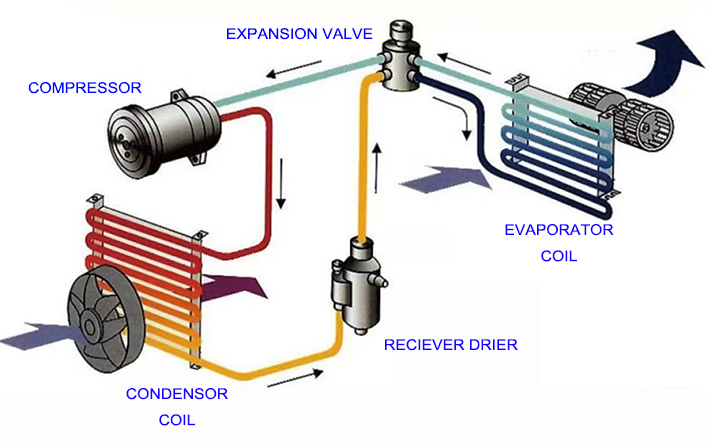Car air conditioning cooling system: detailed explanation of principle and work flow.
2025-03-21
Car air conditioning system is the key to improve driving comfort, and cooling system is its core. This article will delve into the working principle and key component functions of the automotive air conditioning cooling system to help you understand this system.

System composition and function
Automotive air conditioning cooling system is a closed circulation system, mainly composed of the following components:
Compressor: the "heart" of the system, which is responsible for compressing the low-temperature and low-pressure gaseous refrigerant into a high-temperature and high-pressure state to provide power for refrigerant circulation.
Condenser: Usually located in the front, similar to the radiator, through the cooling fan to dissipate the heat of high temperature and high pressure refrigerant to the outside world, so that it is condensed into high pressure liquid.
Liquid storage dryer: Located between the condenser and the expansion valve, it stores refrigerant and filters impurities and moisture to prevent system clogging and corrosion.
Expansion valve: a throttling device that converts high-pressure liquid refrigerant into a low-temperature and low-pressure mist mixture to create conditions for the refrigerant to evaporate and absorb heat.
Evaporator: Located in the car, the low temperature and low pressure refrigerant absorbs the heat in the car to achieve cooling and dehumidification.
Blower: The air cooled by the evaporator is blown into the car to achieve cooling effect.
Detailed explanation of work flow
1. Compression: The compressor inhales the low-temperature and low-pressure gaseous refrigerant from the evaporator and compresses it into a high-temperature and high-pressure state, at which time the temperature of the refrigerant can reach 70-80 ° C.
2. Condensation: The high-temperature and high-pressure refrigerant enters the condenser, and under the action of the cooling fan, the heat is dissipated to the outside air, and the temperature of the refrigerant is reduced and condensed into a high-pressure liquid.
3. Drying and filtration: high-pressure liquid refrigerant flows through the liquid storage dryer to filter out impurities and moisture to ensure stable operation of the system.
4. Throttling: high-pressure liquid refrigerant through the expansion valve, due to the throttling effect, the pressure and temperature drop sharply, transformed into a low temperature and low pressure fog mixture.
5. Evaporation: The low-temperature and low-pressure mist refrigerant enters the evaporator, absorbs the heat of the air flowing through the evaporator surface, and the refrigerant evaporates into low-temperature and low-pressure gas, reducing the air temperature.
6. Circulation: The low-temperature and low-pressure gaseous refrigerant is inhaled by the compressor again to start the next cycle.
Key point analysis
Refrigerant: As a carrier of heat, refrigerant circulates in the system, absorbing and releasing heat through phase transitions (transitions between liquid and gas).
Pressure change: Through compression and throttling, the system changes the pressure and temperature of the refrigerant, creating conditions for the heat absorption and condensation of the refrigerant.
Heat transfer: the condenser will dissipate the heat inside the car to the outside world, and the evaporator will absorb the heat inside the car to achieve cooling in the car.
Summary
Car air conditioning cooling system through the circulation of refrigerant and pressure changes, to achieve the transfer of heat inside the car, to achieve the purpose of cooling. Understanding its working principle and key component functions, and regular maintenance can effectively improve the cooling effect and service life of the air conditioning system, and bring you a more comfortable and healthy driving experience.